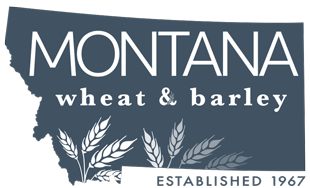It’s a long flight to Washington, D.C., regardless of the route taken, but well worth the time at US Wheat’s annual winter meeting held January 24-26, 2024. The Montana Wheat & Barley Committee (MWBC) sent four representatives: board members Denise Conover, Broadview, and Lee Dahlman, Dutton; and staff members Kent Kupfner and Lori Wickett.
Lee and Lori are providing takeaways from the experience, which was never a dull moment spent in our capital city. If you read no further, at least know this: during board introductions on Friday, Montana was recognized for the significant impact Montana leaders have had for our industry over the years. It is good to know we are valued by friends and colleagues in the business.
From Lee…
Let’s just say that I was confused. As I have not been to a national U.S. Wheat meeting before, nor a National Association of Wheat Growers (NAWG) meeting, I was a bit like a kid needing an owner’s manual. This year the two groups opened with a joint session, called a plenary, where US Wheat and NAWG discussed topics in common. From that point forward, I had trouble knowing which meeting I was supposed to go to!

This experience was super educational. At times I attended dual meetings, and I found differences between the organizations, yet so many similarities. It is good to understand what the goal of each organization is. NAWG is a policy-driven organization. They focus on matters like the farm bill, crop insurance or taking up issues directly with our representatives. US Wheat is focused on global marketing of our wheat. They do not directly get involved with policy, albeit they do have concerns when decision makers might affect foreign trade. Instead, US Wheat focuses mostly on things like what we need to export and how; why a certain country might be a top importer; or why we might have shipping issues in a certain part of the world, such as the Panama Canal. There are dozens of market development conversations and it is a good challenge to keep up with all of them.
I satisfied my curiosity on how new markets become developed through many good US Wheat sessions. Take, for example, a country in South America. If we want to market our wheat to Peru, US Wheat works to open the door, and then begin a discussion with the prospective customer. This often includes a visit by a team we take part in. The US wheat price per bushel can be higher than our competition, because our wheat quality is better, and our shipping can be more expensive. Here’s where NAWG enters the conversation. If US Wheat, in their market development, is hampered by an unlevel playing field, then they can turn over the issue to NAWG to work with policymakers to assist with that burden. That could include shipping regulations, tariffs, or other trade barriers.
This brings me to the Market Access Program (MAP) and Foreign Market Development (FMD), which are both part of the farm bill. These programs are crucial to marketing Montana wheat and opening new opportunities in the global market. It’s important that producers stay in touch on these programs and that they stay in the farm bill as they directly impact our ability to market our products.
I’m writing this thinking, “Does a producer, upon delivering a load of wheat, even care about all this?” They should. Because in the end, price is affected by demand. Maybe even a better answer is a quote from the late Coach Pat Summit, which was repeated during our meetings: “Success is a project that’s always under construction.”
From Lori…
While not my first DC rodeo, this was my first US Wheat meeting and it was impressive. I’ll share three topics I found interesting related to our market development future. By the way, my son might say the military gets the trophy for the most acronyms in an organization, but the USDA cannot be far behind.
RAPP – The Regional Agricultural Promotion Program was newly launched in October, 2023. Housed under Foreign Agriculture Services (FAS), this program is highly targeted to building new markets for U.S. commodities as increased competition from Russia, Ukraine and Australia threaten US market share. The $1.2 billion program covers five years of development, with about $300 million earmarked for 2024. US Wheat is working on their grant application as we speak, for about $22 million.

For wheat producers, this means that new prospects such as Vietnam or Indonesia could see some serious attention this year. There are at least 60 countries in the exploration plan, including increased efforts with familiar customers like Thailand.
Quality and Yield – US Wheat will increase its focus on wheat quality improvement and higher yields. As Montana leads in end-use wheat quality, I expect us to contribute heavily to this conversation. What do we know that we can share with other states to help the entire industry raise the bar on quality? What insights can our breeders gain from other variety developers that can help Montana growers improve yields?
MWBC is in the middle stages of producing a preferred varieties information piece so I’m particularly pleased that US Wheat is advancing this topic.
China – China is now the number-one importer of US Wheat, largely buoyed by their end-of-year rash of purchasing in 2023. I was surprised by this statistic, mostly because Montana producers are so used to selling wheat to Japan and we don’t talk about China all that much locally. Historically, China has consumed mostly soft red winter wheat. Hearing from the USDA last week, China looks to continue their demand – it will be worth understanding if they would turn their interests toward our hard wheats.

